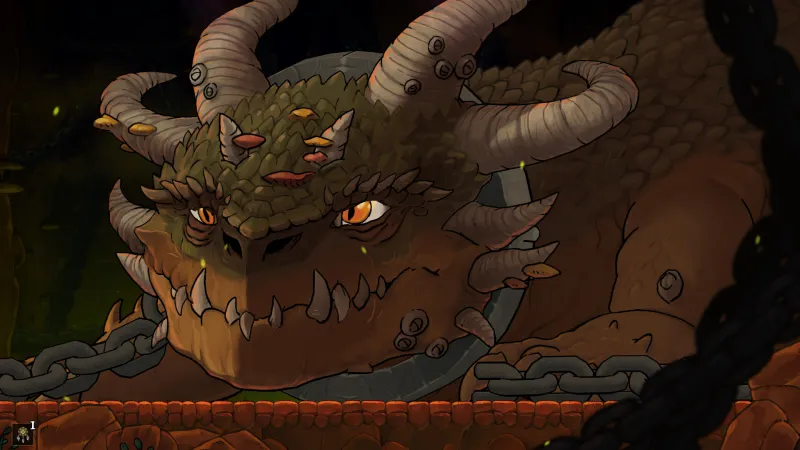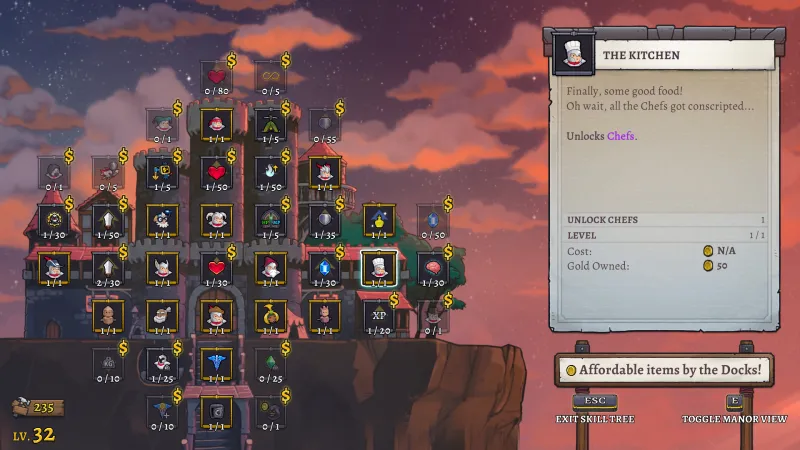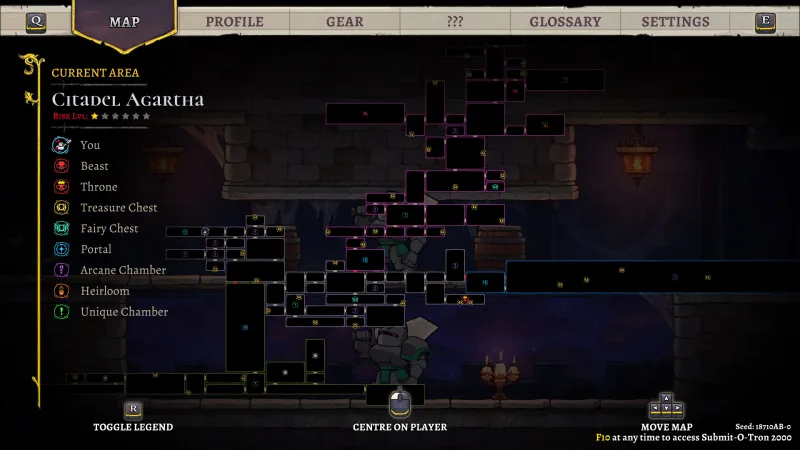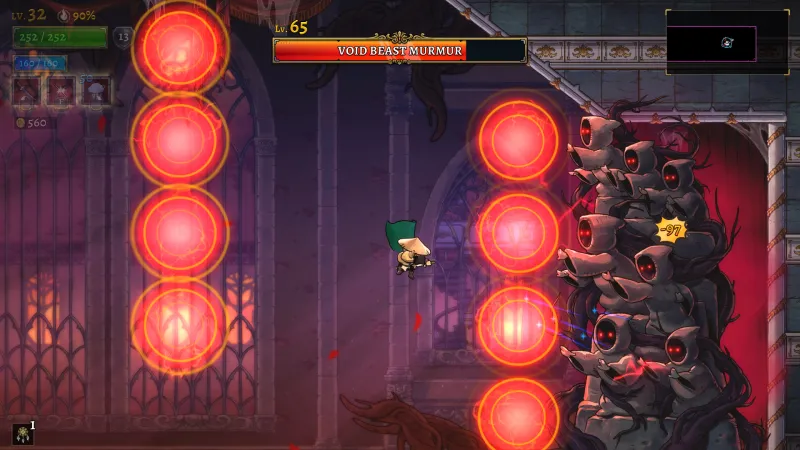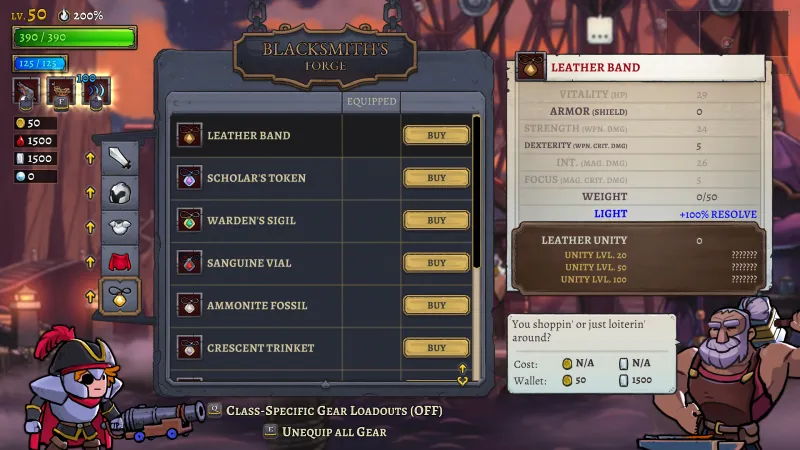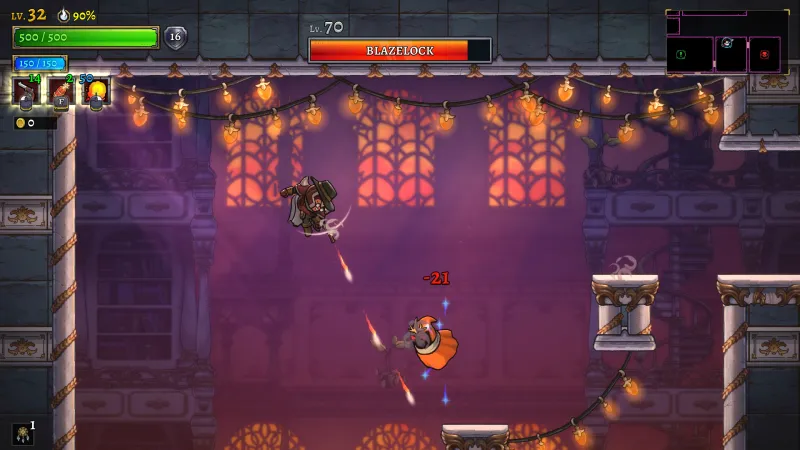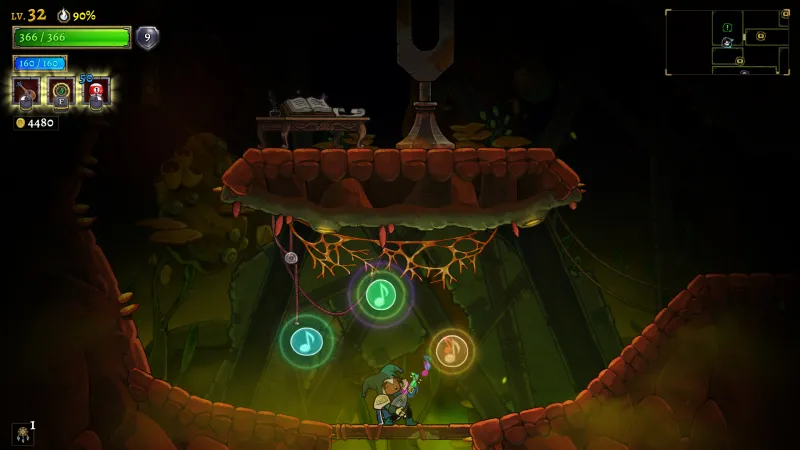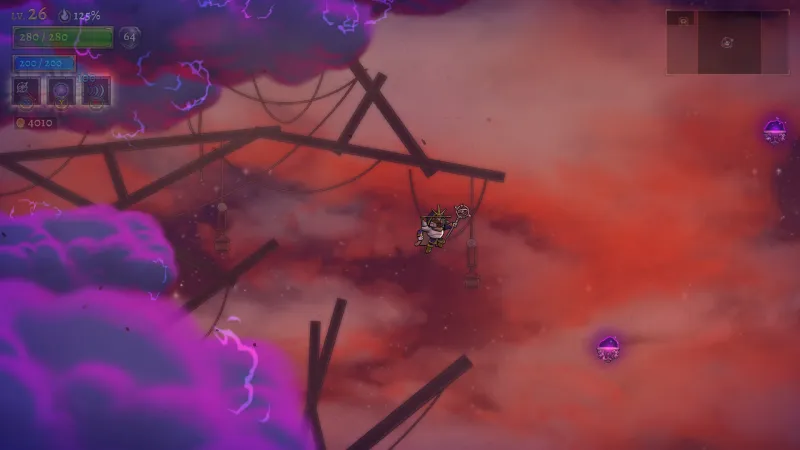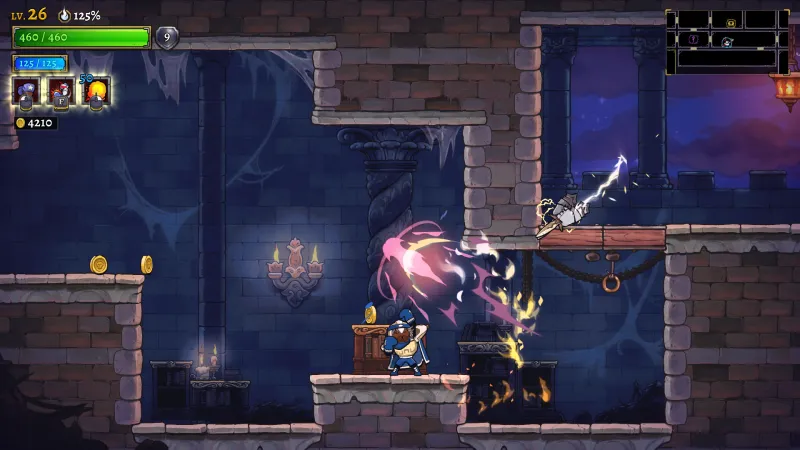
Reviewed on:
PC
Platform:
Xbox Series X/S, Xbox One, PC
Publisher:
Cellar Door Games
Developer:
Cellar Door Games
Release:
April 28, 2022
Rating:
Everyone 10+
Rogue Legacy 2 doesn’t make the biggest initial splash. In fact, at first glance, you’d be hard-pressed to see what’s changed from 2013’s Rogue Legacy to Cellar Door Games’ sequel. Despite switching from 2D sprites to a 3D rendered world, it veers close to the previous game’s aesthetic. While this lack of deviation from the original’s template proves to be a theme throughout Rogue Legacy 2, there are a lot of changes that add up to a bigger, better version of the original in almost every way.
Everything may be rendered in 3D this time around, but Rogue Legacy 2 retains its 2D platforming roots. As an heir to a long and somewhat tragic bloodline, you run, jump, and attack using the weapon of that character’s inherent class. To add some more tools to the combat repertoire, each heir has a special class ability and a random spell tied to separate face buttons. There’s also a nifty spin kick used to bounce off enemies or dangerous objects that’s critical to master to make it far into the dicey dungeons. The controls are tight and precise – making jumping and attacking curse-free affairs. The game is easy to pick up and get used to and, more importantly, easy to return to after some time away.
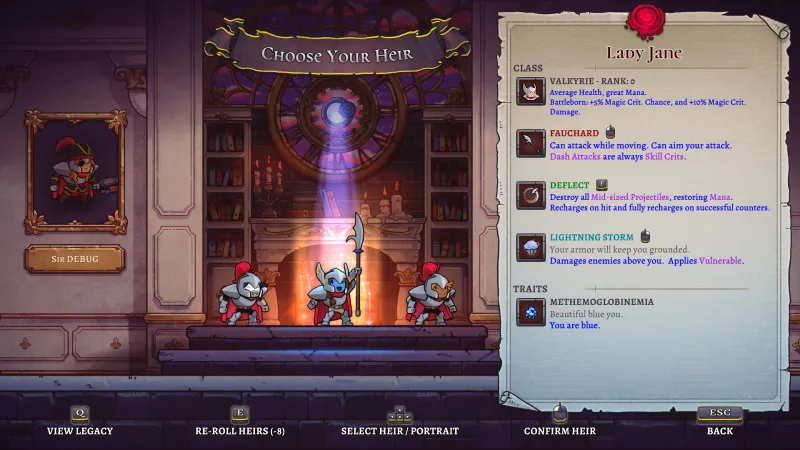
At the start of a run, you choose an heir to your bloodline with specific hereditary traits that make that character’s generation their own for better or worse. I love all the different variations of warriors these traits create, and that you’re rewarded for choosing someone with “bad” genetics. It adds a lot of depth to the rogue-lite concept. One fighter might be a have the characteristic of a giant, towering over their peers. Another may be colorblind, shifting the presentation to greyscale. Someone with unfortunate vertigo flips the world upside-down for that run. Any traits that make the game more difficult result in a significant modifier, allowing for more gold to be accrued throughout that lifetime. These modifiers deliver more than enough wealth to make up for the extra effort given.
With that gold, you can build up the bloodline’s castle, and the port town below it. Skills can be purchased after each run, adding permanent stat increases to every character you play as; strength, intellect, health, and more can be increased along with unlocking more classes to play as. In town, you can craft new gear – which also offers stat bonuses and more with a full set of armor – before forfeiting the remainder of your cash and heading off on a new adventure. I’m glad the persistent upgrades are back, but I do have some problems with the system overall. As more ranks of an upgrade are purchased, the price for the next tier increases for the same flat stat increase, offering diminishing returns on character improvements as the cost to upgrade skyrockets. There are also far too many repetitive upgrade nodes featuring the same stat boosts as others that set you back an even greater amount of gold. By the late game, the castle building menu is cluttered with redundant slots and ends up being a far messier system than it needs to be.
However, class identities are more straightforward and have been greatly expanded upon from Rogue Legacy. This time around, each heir’s class determines which weapon type they use and an additional ability they have at their disposal. Knights comes equipped with a big sword and can block attacks with a shield, while Mages sling fireballs from their wand at a distance and can use two spells instead of one. Rangers can aim and fire a bow and create leafy canopy platforms to fire from in the air. The Pirate can fly around in an airship shooting cannonballs at the foes in its sight. I adore each class identity, even if I found about half of the choices hardly viable for my playstyle. I gravitate towards a specific few like the katana-wielding Ronin and the Boxer, who builds up quick-fisted combos and finishes off-targets with a devastating haymaker. Classes like the Bard, which creates music notes that you detonate with a spin kick, or the Gunslinger, which fires a volley of shots from their pistols, need a bit too much finesse for my liking.
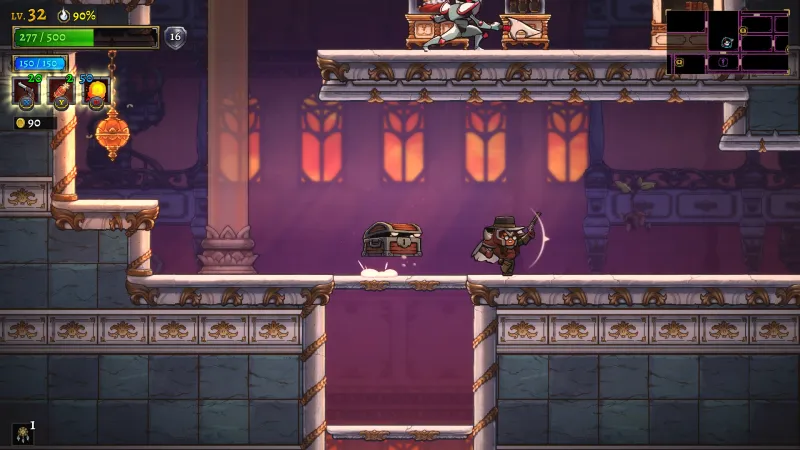
Like Rogue’s visual style, Cellar Door Games decided the gameplay loop wasn’t going anywhere, which is great because I wouldn’t have it any other way. The heir platforms through ever-shifting, increasingly challenging areas to take down six Estuaries, the big bosses guarding each biome. During these battles, you’ll often die, upgrade your castle and gear, then repeat the process. Each trek into the citadel is a chance to progress, collect gold and treasure, and search high and low for ability-enhancing Relics to better your chances of survival. The world’s layout changes every time you die, making every life in Rogue Legacy 2 mostly unique until you understand how the world populates.
Each area has a unique aesthetic and feel. You start in the stone structure of Citadel Agartha and move to the surrounding areas, such as the linear and waterlogged Axis Mundi to the east and the cold tundra of Kerguelen Plateau at the other end of that. There’s a tall tower to be climbed into the stormy skies, offering fun and challenging platforming to reach the Estuary at the top, and below the citadel lies a deadly and dangerous area that I hated going into, yet I love the difficulty it provides near the end of the game. Exploring each area rewards you with armor blueprints to craft in town and important mobility powers that unlock access to the subsequent biomes. These include various types of dashes, double jumps, and abilities that interact with puzzling items in the world that halt your path forward. I found it incredibly satisfying to have a form of progression borne of exploration rather than only being tied to the power gained with castle upgrades. Not to mention these moves make getting around a lot easier and more fun, so I was always ecstatic to stumble across one. Those little nuggets of joy only happen a few times over an entire playthrough, but what keeps an heir’s life interesting are persistent items for that run that affect attacks, abilities, or stats called Relics.
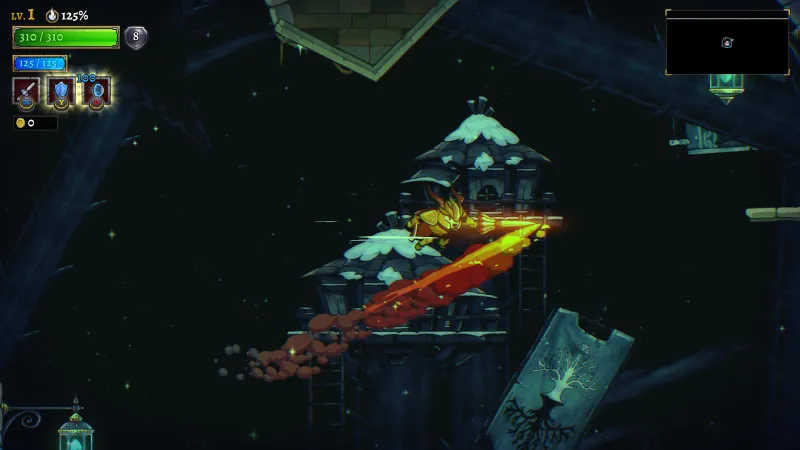
Like the various weapons that come part and parcel with each class, Relics are another addition to the Rogue Legacy formula the original didn’t have, making each run more entertaining. Special rooms in each major area can be found that offer up a Relic. Some are minor changes like increasing the critical hit chance for attacks or granting a maximum health increase at the cost of some HP, while others warp the way you play.
Items like the marble statue, which causes a small projectile-nullifying shockwave whenever your feet touch the ground, are a blast to find and strategize around. I’m also a fan of the poison and fire effects that deal damage over time to add a little extra zing to every attack. However, collecting Relics has a drawback, and it’ll cost you your HP. Relics feed off a stat called resolve that’s tied to a given heir’s vitality. If you have enough Relics in your possession, your max health drops in relation to the resolve cost of the magical item. It’s a risk/reward system that I understand would be too powerful if Relics were unchecked in some way, but I did lament that the game doesn’t let you go wild with every enhancement you find as other rogue-lites do.
Even after spending tens of hours scouring the dungeons of Rogue Legacy 2, there’s a lot to do and find beyond defeating the Estuaries and the final challenges that lie after. Story rooms hold diary entries giving backstories on the Estuaries and the area they lord over, which is intriguing, though not all that essential to enjoying the game. Your seaside port town also offers enemy gauntlets, enhanced boss encounters, and class challenges to test your skills beyond what’s available in the core explorable regions. I know I’ll be going back to uncover more and try to clear these more difficult scenarios.
Despite my nitpicks, every new discovery unveiled, skills obtained, and boss defeated wipes away any grief and replaces it with deep satisfaction. There’s a lot to clean up with the core progression systems to make the ramp from beginning to end escalate more evenly, but I’ve enjoyed most of my hours struggling through countless generations of my goofy little bloodline. I am overjoyed the entertaining heritage of this series remains firmly intact.
Score:
9
About Game Informer’s review system
Source: Game Informer Rogue Legacy 2 Review – Generations Of Greatness


